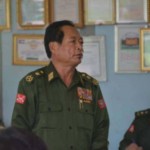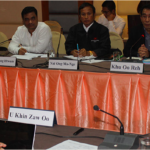By Ye Mon and Lun Min Mang / Myanmar Times | February 02, 2017
The government’s peace commission is set to grant the Kachin Independence Army (KIA) its long-awaited request for an individual meeting, as conflict rages on in parts of northern Shan and Kachin states.
General Gun Maw has confirmed the KIA received a letter from the peace commission on January 27, expressing interest in a sit down. The development was also confirmed to The Myanmar Times by a member of the government’s negotiating commission.
Peace commission advisory team head U Aung Kyi said exact details on meetings with the armed ethnic groups had yet to be finalised.
“We have informed them that we are willing to have an open discussion with them individually,” he said.
Talks have been delayed due to a communication breakdown between the government and the KIA, which is a non-signatory to the Nationwide Ceasefire Agreement. The influential armed group is currently engaged in hostilities with the Tatmadaw .
“We would discuss bilateral affairs when we meet and specific matters related to the government and KIA only,” said U Aung Kyi.
The KIA had reportedly been requesting a meeting since late 2016, but has become engaged in fending off fierce offensives in Kachin State.
KIA communication officer Lieutenant Colonel Naw Bu told The Myanmar Times yesterday that the KIA would discuss matters related to ceasefire and political negotiations.
However, he refused to be drawn on whether or not the KIA would participate in the next round of the 21st Century Panglong meetings this month.
“Concerning the Panglong conference, we will attend as a member of United Nationalities Federal Council. UNFC officials have already said they will not attend if invited as observers, so I cannot say for sure if we are attending or not – it depends on the government,” he said.
Setbacks stall NLD-govt’s initial foray into the peace process
The KIA is a member of the UNFC, a coalition of seven non-signatory groups, which recently released a statement after a meeting of the group was held this month. The UNFC is calling for a meeting with State Counsellor Daw Aung San Suu Kyi and Tatmadaw Commander-in-Chief Senior General Min Aung Hlaing.
In June 2011, a two-decade ceasefire broke down after skirmishes between the KIA and Tatmadaw. Since then, the two armies have engaged in sporadic fights, many of which have seen tens of thousands displaced.
KIA officials claim they have faced an escalation of offensives following their appearance at the August 2016 Panglong meet.
In November 2016, a joint offensive was launched in northern Shan State by the Northern Alliance-Burma (NA-B), a new coalition comprised of the Ta’ang National Lilberation Army, the Arakan Army, the Myanmar National Democratic Alliance Army and the KIA’s brigades 4 and 6.
The NA-B sub-groups are mostly non-signatories to the NCA, who have expressed that the offensive was “inevitable” for them.
In an interview with Radio Free Asia, General Gun Maw of the KIA said there would be certain issues that the KIA would want to discuss privately with the government – as well as the use of “terrorist” designation.
The Shan State parliament last year decided to designate the Northern Alliance a “terrorist organisation”, which drew criticism from leaders of both NCA signatory and non-signatory ethnic armed groups.
This article originally appeared on Myanmar Times on February 2, 2017.






